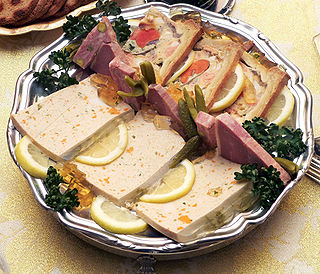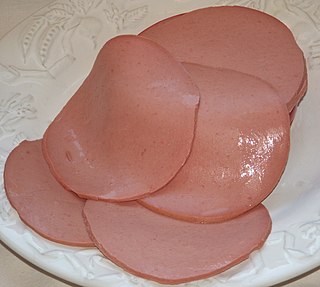
Cajun cuisine is a style of cooking developed by the Cajun–Acadians who were deported from Acadia to Louisiana during the 18th century and who incorporated West African, French and Spanish cooking techniques into their original cuisine.

A sausage is a type of meat product usually made from ground meat—often pork, beef, or poultry—along with salt, spices and other flavourings. Other ingredients, such as grains or breadcrumbs may be included as fillers or extenders.

Hungarian or Magyar cuisine is the cuisine characteristic of the nation of Hungary and its primary ethnic group, the Magyars. Traditional Hungarian dishes are primarily based on meats, seasonal vegetables, fruits, bread, and dairy products.

A blood sausage is a sausage filled with blood that is cooked or dried and mixed with a filler until it is thick enough to solidify when cooled. Most commonly, the blood of pigs, sheep, lamb, cow, chicken, or goose is used.

A fried egg is a cooked dish made from one or more eggs which are removed from their shells and placed into a frying pan and fried. They are traditionally eaten for breakfast in many countries but may also be served at other times of the day.

Chorizo is a type of pork cured meat originating from the Iberian Peninsula.

An offal, also called variety meats, pluck or organ meats, is any organ of a butchered animal. The word does not refer to a particular list of edible organs, and these lists of organs vary with culture and region, but usually excludes skeletal muscle. Offal may also refer to the by-products of milled grains, such as corn or wheat.

Meatloaf is a dish of ground meat that has been combined with other ingredients and formed into the shape of a loaf, then baked or smoked. The final shape is either hand-formed on a baking tray, or pan-formed by cooking it in a loaf pan. It is usually made with ground beef, although ground lamb, pork, veal, venison, poultry, and seafood are also used, sometimes in combination. Vegetarian adaptations of meatloaf may use imitation meat or pulses.

Danish cuisine originated from the peasant population's own local produce and was enhanced by cooking techniques developed in the late 19th century and the wider availability of goods during and after the Industrial Revolution. Open sandwiches, known as smørrebrød, which in their basic form are the usual fare for lunch, can be considered a national speciality when prepared and decorated with a variety of fine ingredients. Hot meals are typically prepared with meat or fish. Substantial meat and fish dishes includes flæskesteg and kogt torsk with mustard sauce and trimmings. Ground meats became widespread during the industrial revolution and traditional dishes that are still popular include frikadeller, karbonader and medisterpølse. Denmark is known for its Carlsberg and Tuborg beers and for its akvavit and bitters, but amongst the Danes themselves imported wine has gained steadily in popularity since the 1960s.

A saveloy is a type of highly seasoned sausage, usually bright red, normally boiled and available in most fish and chip shops around England. It is occasionally also available fried in batter.

Hungarian sausages are sausages found in the cuisine of Hungary. Hungary produces a vast number of sui sausage types. They may be boiled, fresh or dried, and smoked, with different spices and flavors, "hot" or "mild". Many were influenced by their neighbors and brethren.

Soup is a primarily liquid food, generally served warm or hot, that is made by combining ingredients of meat or vegetables with stock, milk, or water. Hot soups are additionally characterized by boiling solid ingredients in liquids in a pot until the flavors are extracted, forming a broth. Soups are similar to stews, and in some cases there may not be a clear distinction between the two; however, soups generally have more liquid (broth) than stews.

Bologna sausage, informally baloney, is a sausage derived from the Italian mortadella, a similar-looking, finely ground pork sausage, originally from the city of Bologna. Typical seasonings for bologna include black pepper, nutmeg, allspice, celery seed and coriander, and, like mortadella, myrtle berries give it its distinctive flavor.
Smörgåsbord is a buffet-style meal of Swedish origin. It is served with various hot and cold dishes.

Knipp is a type of sausage made by mixing meat with grains (Grützwurst) related to Pinkel which comes from the Bremen and Lower Saxony regions of Germany.

Black pudding is a distinct regional type of blood sausage originating in the United Kingdom and Ireland. It is made from pork or beef blood, with pork fat or beef suet, and a cereal, usually oatmeal, oat groats, or barley groats. The high proportion of cereal, along with the use of certain herbs such as pennyroyal, serves to distinguish black pudding from blood sausages eaten in other parts of the world.

Pea soup or split pea soup is soup made typically from dried peas, such as the split pea. It is, with variations, a part of the cuisine of many cultures. It is most often greyish-green or yellow in color depending on the regional variety of peas used; all are cultivars of Pisum sativum.

The Goan sausage or chorise is a typical reflection of Indo-Portuguese cuisine from Goa, which once were part of the Portuguese State of India. It is based on the chorizo sausage, introduced from Portugal. The humidity of Goa made it difficult to produce European-styled sausages that would keep, and so the meat was pickled in vinegar, alcohol and a chilli-spice mix before being placed in pig-gut. The Goan sausage is therefore of Iberian origin and related to the Spanish Chorizo, both of which go through a process called "pimenton".

Embutido, or embotido, is a Philippine meatloaf made with ground pork and stuffed with hard-boiled eggs and sliced ham or various sausages. It is traditionally wrapped in aluminum foil and steamed, though it can also be baked.


















